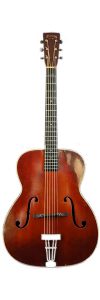MARTIN F-1 reviews
MARTIN F-1
Reviewed by: Brent
Date: 2022
Martin started making archtop guitars in 1931, with the smaller R (00 size) and C (000 size) series. They started making 16" wide F-series archtops in 1935. At the time, the F-9 at $250 was the most expensive guitar that Martin made (a 000-45 was only $175). In 1940, Martin started making the F-1. These were made for only three years, with a total of 91 produced (coincidentally, the same as the number of pre-war D-45s). Workmanship is outstanding, as you would expect of a pre-war Martin. The F-1 had mahogany back and sides, compared with Brazilian rosewood in all the other F-series models. Fretboard is ebony, which is kind of unusual for a mahogany guitar after the 30s. In 1940, the F-1 cost $85, which was $5 less than a 000-28. Martin got into making archtops late in the game, by which time Gibson and Epiphone already dominated the scene.
Martin archtop guitars do not sound like Gibson and Epiphone archtops. Jazz players went for the Gibson/Epiphone sound, which was the downfall of Martin archtops. Martin archtops are less percussive with more bass and sustain, somewhere between a classic archtop sound and a flat top guitar. I guess that is what you would expect of an archtop guitar made by the premier flat top guitar maker. However, this makes it a fairly versatile guitar compared to most archtops. It does a nice job with bass-strum flatpicking, and leads really cut through. I think of Mother Maybelle Carter playing early country music on her Gibson L-5 and think that she might have been happier with a Martin archtop. We all know how a guitar sounds very different out in front compared to from a playing position. This is accentuated in these archtops. The sound difference between when you are playing and when you are out in front listening is huge. These have a ton of volume, although it doesn't seem like it when playing.
Bottom line - if you need to sound like the classic jazz players, get a Gibson or Epiphone. If you are more eclectic and like more bass and sustain while still getting the archtop punch, then you might find the Martin archtops an interesting alternative. The 16" wide F-series gives the most volume and the mahogany F-1 is the most affordable of those. However, they are not easy to find.
Link to review: view
MARTIN F-1
Reviewed by: Patrick Williams
Date: 2020
Overall design: The F-1 was not "built like an archtop". The body is constructed like a flat-top, and while there is some arch in the spruce top, it's not as deep as those from other makers. But because of that arch and the body construction, the neck has a pretty extreme angle (if you lay an F-1 on a flat surface, it only comes in contact at the top of the headstock and rear edge of the body). Body wood is very thin. I have read that this was Martin's first 16x20 instrument and after they retired the F series, this body size was renamed the 000.
Sound and playability: This guitar has a wonderful tone and great bass response (unusual in an archtop). The wood in the body is quite thin and the instrument is very light. But, because of this, it really sits up and barks when you give it a firm attack. The neck angle makes playing it a challenge, however. Holding the neck in a position where it is playable means you have to stuff the lower bout in your armpit or stand and have it hanging quite low. Not an easy instrument to play with a decent sitting posture.
Quality of construction: This is made the pre-war Martin way and is quite a well put together instrument (particularly for being the 'entry level' to the F series). Body wood is thin, as mentioned, which makes it loud. T-bar in the neck, and 80 years later is still quite straight, but with perfect relief at the 5th fret with string heights 5/32 on the bass and 3/32 on the treble at the 12th fret.
Durability: This guitar has held up pretty darned well. It appears to have had some cracks in the sides repaired at some time (there are several thin strips of fabric running against the grain of the inner walls of the sides), but whoever did the repairs refinished the entire guitar (bleaching the top as well - you can still see the ghost of a sunburst).
Value for money: I paid around $670 for this in a used guitar shop in Anchorage, Alaska in around 1987. I've always been quite happy about the purchase. The F-1 is not an investment instrument. Too few people know about them, and they are not nearly as fancy as the other members of the series. But it is a good player.
Product support: I reached out to Martin shortly after getting this guitar to date its manufacture. The person I talked to had no idea there was an F series, and, of course, the records of the series were 'not available'.
Link to review: view
